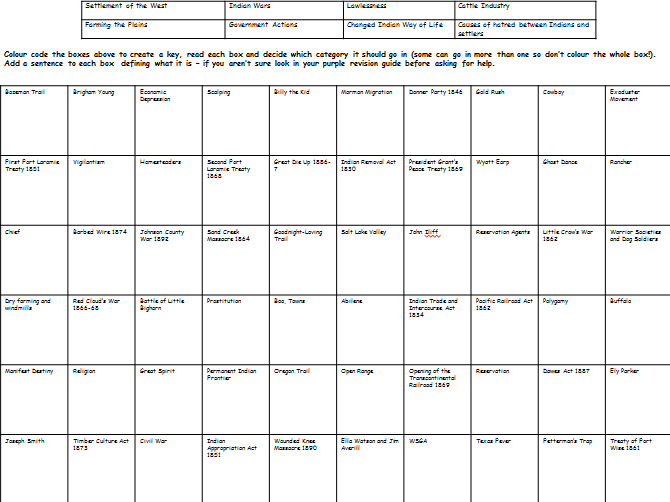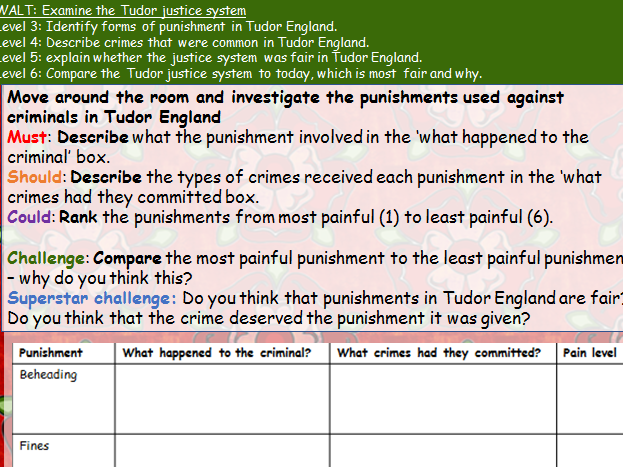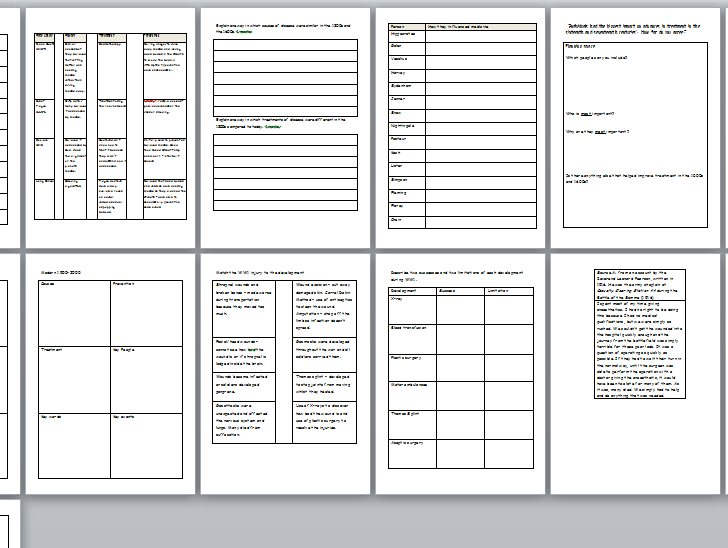
177Uploads
72k+Views
23k+Downloads
History

Command word display
Bunting that includes command words for the new specification:
identify, describe, explain, define, recall, evaluate, infer, compare, evaluate

Chronology (What is history? (KS3))
Pupils explore the concept of chronology and how it supports historical learning, they are also introduced to the concept of a turning point and identify turning points in their own lives/across history. Includes a chronological order game of significant events from history.
WALT: define chronological order and apply this skill to historic events.
L3: Define what the term chronological means.
L4: create a timeline of events from history in chronological order.
L5: Explain what a turning point is.
L6: Apply skills to a timeline of my own life and evaluate the biggest turning point in my life so far.

Weimar and Nazi Germany Timeline and Lesson (Edexcel 9-1)
Timeline with sections for pupils to create - worksheet to support.
Fully differentiated lesson to go alongside the timeline.
Starter: structure of Paper three
task one: overview video
Task two: timeline - defining key words, describing key events and extension task
Whiteboard AFL
Task Three source work - why vote for hitler? challenge: making links to key events on the timeline
Task designed as an introductory lesson to paper three to give pupils an overview of the topic so assumes no prior knowledge but could also be used as a revision task.

Henry VIII Wives
Full lesson and homework. Pupils evaluate which wife Henry loved most by firstly completing a carousel activity that allows them to explore each wife and the reasons Henry divorced her before creating an extended writing piece (differentiated) about who he loved most.
Homework: to write a letter to the Pope explaining why you want a divorce from Katherine of Aragon.
WALT: Evaluate who Henry loved most.
Level 3: Identify Henry’s six wives.
Level 4: Describe each of his wives and what happened to them.
Level 5: explain why Henry divorced each wife.
Level 6: Compare which wife was Henry loved most, give reasons why.

Votes for Women! Suffragists and Suffragette’s interpretation lesson
stand alone lesson to celebrate the centenary of votes for women and to provide pupils with an overview of the subject.
Pupils describe the two groups (suffragists and suffragettes) and will gain an understanding of the words militant and moderate. Pupils will also be able to explain why women were not allowed the vote and eventually gained the vote following WW1.
Skills building section develops pupils ability to analyse interpretations.

REVISION American West Thinking Quilt (Edexcel 9-1)
American West thinking quilt designed to provide pupils with the opportunity to make links between different events and consider their impact on the development of the American West.
I have checked through both the Pearson textbook and revision guide to ensure that all key content is included in this A3 thinking quilt.
Pupils first read the boxes and add a sentence to any that they are not sure of with the support of peers, revision guides or the teacher.
They then colour code them based on catagories they could fit into such as ‘law and order’ and ‘conflict with Plains Indians’.
You can find the lesson that this thinking quilt is a part of here:
https://www.tes.com/teaching-resource/revision-key-features-of-the-american-west-edexcel-9-1-11884964

The Power of the Godwin Family and Normandy Embassy (Anglo-Saxon and Norman England (Edexcel 9-1))
WALT: Evaluate the power of the Godwin family.
2-3: Recall key facts about the Godwin family.
4-5: Describe the importance and power of the Godwins in England.
6-7: Explain what happened during Harold’s embassy to Normandy and why it might cause problems.
8-9*: analyse how useful Norman sources are to a historian.
Pupils examine the power of the Godwins and how their influence both helped and hindered Edward’s rule
They then explore the Normandy embassy using the Bayeux tapestry and the Norman and Saxon interpretation of the event.

KS3 Pearl Harbour (WW2)
Full lesson with differentiated activities
Pupils will:
WALT: Explain the causes and consequences of the attack on Pearl Harbour.
Level 3: Identify what Pearl Harbour was and who was involved.
Level 4: Describe the causes of tension between America and Japan.
Level 5: Explain what happened at Pearl Harbour and how America joining the war might affect the outcome of WW2.
Level 6: Analyse a source to explain why it is useful and limited to a historian.

KS3 Hitler's Downfall (WW2)
This lesson covers:
The Battle for Berlin
Hitler’s suicide
Yalta Conference
Pupils will:
WALT: Explain why the Nazi’s surrendered to the Allies and the importance of Yalta.
Level 3: Identify what position Germany was in by 1945.
Level 4: Describe the key events of the Battle for Berlin.
Level 5: Explain how the Battle for Berlin lead to Germany surrendering to the allies.
Level 6: Compare sources to analyse what the Big Three wanted at Yalta and how this would affect Germany.

WW1 Medicine Revision Session (Edexcel 9-1)
Session covers the Western Front section of the Edexcel history 9-1 course.
Pupils cover:
features of a trench
features of the main battles
key medical problems
key medical advances
blood transfusions and x-rays (problems and solutions)
following up a source

KS3 D-Day (WW2)
WALT: Explain why the Axis forces were defeated at D-Day.
Level 3: Identify hidden messages in US propaganda.
Level 4: Describe the key events of the D-Day invasion.
Level 5: Explain why Allied tactics lead to success.
Level 6: Compare the Allies and German tactics to explain why the Allies won.
Pupils analyse a source, follow a carousel to create the battle plan shown as the cover image, then read a source to compare British and German weaponry before creating a newspaper article about the invasion.
Bundle

KS3 Elizabeth I
Full scheme of work consisting of 9 lessons exploring the reign of Elizabeth I.
All lessons fully differentiated and designed to embed skills required for the reformed GCSE’s.
Topics in order of teaching are:
Who was Elizabeth?
Who should marry Elizabeth?
Poverty and the poor laws
Education
Entertainment
Mary Queen of Scots - whats the problem?
Mary Queen of Scots - plots and execution
Armada - causes
Armada - events narrative account

Introduction to the Civil Rights Movement (KS3)
Part of a three lesson SOW about the CRM in America.
WALT: Evaluate methods used to fight for equality in 1960s America.
Level 3: Identify the meaning of the phrase Civil Rights
Level 4: Describe the Jim Crow Laws and examples of how they linked to life in the 1960s
Level 5: Explain methods in which Civil Rights leaders fought for equality.
Level 6: Analyse the methods you think would be most successful and explain why.
Starter: what does Civil Rights Movement mean? using Frayer model
task one: video task
Task two define and describe the Jim Crow Laws using images
Task three: describe and explain methods of protest
task four: analytical discussion and annotation of President Kennedy’s Civil Right’s Address.
Plenary: 3 - 2 -1 plenary task

Tudor Crime and Punishment
This is a lesson aimed at KS3, it provides an overview of crime and punishment in Tudor times.
Pupils complete a carousel around the room in order to analyse the punishments that people received for certain crimes.
They then decide which punishments the criminals deserve (Anne Boleyn and Thomas Cromwell included) before comparing whether the Tudor justice system is fair with today’s justice system.

Design your own Norman castle (Stone keep and motte and bailey)
Full lesson
Pupils are given a budget and key features of a castle, they must make their own castle and then must attack their partner's castle. Aimed at year 7 pupils studying life in Norman England.

Who was Henry VIII?
Introductory lesson for Henry the Eighth. Pupils compare reasons Henry is remembered as a good and a bad king to come to a conclusion as to how they think he should be remembered.
Pupils also answer an interpretation question - training for the new GCSE reforms.
WALT: Explore the type of king Henry VIII is remembered as.
Level 3: Identify what makes a good king.
Level 4: Describe the type of person Henry VIII was.
Level 5: explain how features of Henry’s personality made him a good king.
Level 6: assess the main difference between two interpretations.

REVISION Medicine Through Time and Western Front Overview
An hour and a half lesson aimed at intervention prior to the examination.
pupils are given an a5 booklet to follow along with the session, parts of which can be completed at home to build knowledge as last minute revision. This is the last session I use prior to Paper One.
Pupils cover:
key people, key discoveries, skills for all question types, source evaluation and judgement.

REVISION CLOCK: Stresemann changes to Germany (Weimar and Nazi Germany Edexcel 9-1)
The concept of a revision clock is that pupils spend five minutes completing each section - thus meaning they revise a large amount of a single topic in an hour.
this resource includes two revision clocks, i plan to provide my pupils with it printed double sided, they will complete one side in class and one side for homework.
Another technique is to ask pupils to fill out what they know in one colour, and then use a second colour to revise using a revision guide or textbook, giving them a colour coded guide to what they need to focus their revision on.

REVISION CLOCK: Weimar and Nazi Germany (Edexcel 9-1)
The concept of a revision clock is that pupils spend five minutes completing each section - thus meaning they revise a large amount of a single topic in an hour.
this resource includes two revision clocks, i plan to provide my pupils with it printed double sided, they will complete one side in class and one side for homework.
Another technique is to ask pupils to fill out what they know in one colour, and then use a second colour to revise using a revision guide or textbook, giving them a colour coded guide to what they need to focus their revision on.

AMERICAN WEST REVISION CLOCK (Edexcel 9-1: The American West)
The concept of a revision clock is that pupils spend five minutes completing each section - thus meaning they revise a large amount of a single topic in an hour.
this resource includes two revision clocks, i plan to provide my pupils with it printed double sided, they will complete one side in class and one side for homework.
Another technique is to ask pupils to fill out what they know in one colour, and then use a second colour to revise using a revision guide or textbook, giving them a colour coded guide to what they need to focus their revision on.




















